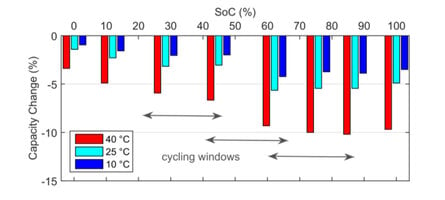The research are extensive. It is work of science. You can be sure that the sum of the research is valid.
The cells where calendar aging are tested are tested st many different temperatures and different SOC, even if it will make any difference if the cells are charged to for example 70% or discharged to 70%.
Science split the degradation into calendar aging (”time”) and cyclic aging (charging/discharging).
The mechanisms for degradation from calendar aging is looked into, so knowing these we can safely say that calendar aging works in a certain way.
The same is valid for cyclic aging.
There are tests for all different charge rates, in different temperatures etc.
So the mechanisms behind degradation from fast charging is found and known (mainly lithium plating).
The possibility for a cell to revert from for example lithium plating is also tested and the mechanisms behind this is known.
For cycles they most often cycle the cells more than you ever will be cycling your cells in any EV ever. So the cyclic data is actual test data.
For calendar aging the most tests are 1-2 years. But there are tests for fice years as well.
As the mechanism behind calendar aging is known, 1 year is good enough and two or five years only confirm what we already know.
We do not need a ten tear test as it will only confirm the square root behaviour. The reason for the square root behaviour is known, and matches the basic math from that. Calendar aging and nice cycles build Solid Electrolyte Interphase (SEI), which consumes lithium to build. At the same tine the SEI scts as a protection from furter SEI build up so the rate of SEI build up gets slower and slower.
Nope, thats wrong.
Its exactly the opposite. Despite many many different ways if testing the results are very close.
We can predict how a EV battery will degrade frommthe test data.
That is also wrong.
The actual cars degradation matches the research very well.
A cell will behave the same way in a pack even if there is a BMS looking after it.
Just like your doctor can not stop ypu from aging, the BMS can not.
Calendar aging and cyclic aging will about the same.
You better start to believe it, or get a hat built from aluminium foil.

It is the real world and it works like that.
I only had my M3P for 2.5 years but the degradation was less than half compared to other cars. With data from the new owner I know that is still is very much better than the other M3Ps with the same battery, now at 3.5 years.
The same is valud for my one year old MSP.
Other MSP’s in the area has much more than the double degradation after the same time.
And we also start to have a descent amount of cars hete at TMC ising this technique and having really low degradation.
Are you thinking these cars suddenly at some point will increase the degradation rate by far to be at the same level on the 10:th anniversary?
The Tesla battery degradation chart you used most probably only show the reduction in displayed range (as more or less all of these use range data and not BMS capacity numbers).
As the car starts with an overhead to the displayed range, the capacity can drop a few percent without the range dropping. This effectively hides the first degradation but still the battery looses capacity so there is a real loss of these percebts in real range.



